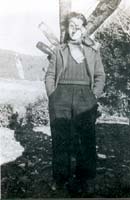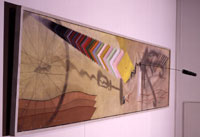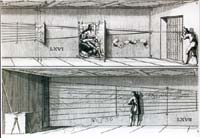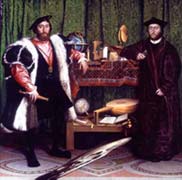by Craig Adcock
With Desargues' terminology such as "tree," "trunk," "branch," and "limb" in mind, these works look positively geometrical. In Network of Stoppages, for example, the pattern of lines resemble branches, especially if the painting is rotated ninety degrees clockwise. In the background, the nude woman in "Young Man and Girl in Spring," the first layer of Network of Stoppages, is then centered in the boughs of the tree. From this perspective, she becomes a precursor for the Bride as an "arbor-type." In the Bottlerack, the prongs appear to be rotated around a central axis (an arbre) and suggest reiterated line segments (rameaux or branches). That these interpretations can be taken seriously is reinforced by an interesting photograph of Duchamp taken in 1942 showing him standing in front of a tree that has been provided with prongs so that it can act as a bottle dryer (Fig. 20). A number of bottles, which have been hung upon this "arbre-séchoir," can be seen behind Duchamp, and he has a network of linear shadows, which have been cast from the branches of the tree, falling across his face.(57)
On the right-hand side of the canvas, there is an irregular, open-sided rectangular "solid." The left side of this solid is a white surface that recedes into the space of the canvas according to one-point perspective. From each corner of the white surface, two lines, drawn with the templates of the Three Standard Stoppages, extend at more or less right angles toward the right. One of each of these is black and the other red. The black lines at all four edges are drawn with the same template. Each set of lines at the upper boundary of the solid cross one another at two points, and each set are drawn in the same way. The two lines at the lower edges of the solid do not cross one another, and they are rotated and inverted with respect to one another. There are also a series of color bands (twenty-four in all) extending orthogonally back into the space of the "solid," or into its virtual shape. They seem to continue on behind it. These bands are connected to the curved line segments that comprise the ambiguous edges of the transparent solid, a volume we could think of as a 3-space with fluctuant, transparent faces. Each of the color bands is surrounded by a number of concentric circles that also recede back into the painting's virtual space according to one-point perspective. The vanishing point coincides with the bottom edge of the canvas just to the right of center below the indexical hand, which, incidentally, is a hand-painted readymade element executed by a certain A. Klang, a sign painter Duchamp hired to carry out this task. Klang's minuscule signature is visible near the sleeve. Duchamp's complex geometrical arrangement is made even more complex by the shadow of the Hat Rack, which occupies the same region of the canvas as the "solid." On one level, the Hat Rack resembles a tree, and the shadows cast from its multiple branches suggest yet another "arbor-type." We know that the Bride is based, in part, on the idea of the cast shadow, "as if it were the projection of a four-dimensional object."(61) The way the Hat Rack interacts with the "solid" is indicative of the complexities that would be involved in such spaces: The lines and color bands seem to overlay the shadow, but the shadow seems to overlay the white rectangle at the left side of the "solid." The shadow can thus be read as both in front of and behind the chunk of space outlined and bounded by the elements of Duchamp's design. The spatial complexities of Tu m' can also be seen in the recession of its orthogonals. They plunge backward in a way that is comparable to the convergence of orthogonals in the Large Glass. In the former, the lines come together just at the lower edge of the painting, in the latter, just at the upper boundary of the Bachelors' domain. In Tu m', the vanishing point is where the "solid" (and also its edges drawn with the Three Standard Stoppages) would disappear. In the Large Glass, the point is at the center of the three plates of glass running across the Bride's horizon. It is where these "lines" would disappear, if rotated ninety degrees. The Bride's garments, when thus folded up, can be taken as orthogonals to a point of intersection--the intersection of parallel lines at infinity. In Euclidean geometry, parallel lines do not intersect. The mathematical convention that they do intersect at infinity was one of Desargues' important contributions. (Parallel lines do seem to intersect at the vanishing point of a perspective system, which may have given Desargues his idea.) Thinking of parallel lines as meeting at infinity eventually contributed to the development of non-Euclidean geometries in the nineteenth century.(62) The conceptual point where parallel lines meet cannot be seen, any more than the curvature of space can be perceived directly. If the curved lines in the Three Standard Stoppages are taken as references to non-Euclidean lines of sight, then they are fundamentally hidden in "garments" of the Bride, just as the vanishing point in Tu m' seems to disappear off the edge of its hyperspatial expanse. The left side of Tu m' is also complicated. In addition to the shadows of the Bicycle Wheel and the Corkscrew, lines drawn with the templates of the Three Standard Stoppages are placed at the lower left-hand side of the canvas. Each of these line segments is at the edge of three curved surfaces that seem to fall back into the space of the canvas. If these irregular planes are thought of as a "pencil of surfaces" (Desargues uses the term "ordonnance de plans"), they would withdraw downward at more or less right angles to the space of the canvas toward a line of intersection located at an infinite distance. (Desargues says that a sheaf of parallel planes can be imagined converging at an "essieu," an "axle," just as an "ordinance of lines" can be imagined intersecting at a "point à une distance infinie.")(63) The edge of the upper member of this pencil of planes is black, and it is drawn with the same "stoppage" that was used at each edge of the rectangular "solid" on the right side of the canvas. The edge of the line segment in the middle register was used as the other line at the edges of the upper boundary, and the edge of the line segment in the lower register was used as the other line at the edges of the lower boundary of the "solid." The shadow of the Bicycle Wheel seems to overlay this arrangement of superposed curved surfaces. There is also a sequence of flat color squares receding according to a plunging perspective back from the center of the canvas into an infinite space at the upper left corner of the canvas. This arrangement of color squares seems to overlay the shadow of the Bicycle Wheel. In contrast, the shadow of the Corkscrew, which seems to spiral out from the axle of the wheel, overlays the color squares. Reading the shadows as riding on the surface of the actual canvas is thus complicated by their relationships with objects occupying the virtual space depicted "inside" the canvas. Duchamp further emphasizes the spatial oddities of his picture by using various forms of "intersection." The corkscrew intersects the canvas by seeming to spiral into it; the safety pins pierce the surface of the canvas; and the bottle brush and the bolt go through the front side of the picture and are fastened to it from behind.
Duchamp is obviously playing with real and represented objects and with real and represented space in Tu m'. To further complicate the issues, he paints a trompe l'oeil tear in the surface of the canvas, which is held together by the real safety pins. In addition to these ready-made elements, the bottle brush juts out from the tear at right angles to the canvas. As an actual object, a readymade, the bottle brush casts actual shadows that can be contrasted with the virtual shadows of the Bicycle Wheel, the Corkscrew, and the Hat Rack, which Duchamp traced onto the surface with pencil. In terms of its geometry, the bottle brush is really only visible when we look at Tu m' from the side, at an oblique angle (Fig. 22). When we view the canvas straight on, all we see is the end of the brush. Looking at the canvas from the side also allows us to see the other elements of the painting, and they seem less stretched out, less constrained by the plunging perspective. The shift is particularly apparent in the sequence of color squares at the upper left side of the canvas. In fact, we now notice that these shapes are not really squares, but parallelograms that look more "natural" from the side than from the front.
Duchamp probably learned something about these kinds of anamorphic effects during the period he was working at the Bibliothèque Sainte-Geneviève in Paris. One of his notes for the Large Glass, which he wrote at this time, suggests consulting the library's collection: "Perspective. See the catalogue of the Bibliothèque Sainte-Geneviève. The whole section on perspective: Nicéron (Father J.-F.), Thaumaturgus opticus."(64) Many of the books on perspective available to Duchamp at the library deal with the unusual, or "aberrant," systems used in anamorphosis. These include works by Father Jean-François Nicéron, whom Duchamp mentions by name in his note.(65) One of Nicéron's images from Thaumaturgus opticus (Fig. 23) is evocative of Tu m', especially if the sketch is fully extended (the left-hand side of the upper part continues at the right-hand side of the lower part).(66) Thus reconnected, the long, narrow dimensions of the image approximate those of Tu m'. Duchamp may also have seen a similarity here between the string held by the assistant in the left-hand part of the drawing and the segments of string in Three Standard Stoppages. In Nicéron's illustration, as in perspective drawings generally, the curling end of the line is meant to indicate that it is a thread used in the construction of the image, rather than being an integral element of the imagery.
Duchamp's thread is more complex. The strings in the Three Standard Stoppages are themselves spaces, one-dimensional spaces, and they are intended to indicate a more difficult geometry than the one Nicéron had in mind. But Duchamp's manner of taking an oblique view and his interest in observing a scene through a visual system rotated away from normal space, is very similar to the way Nicéron turns his outstretched images onto the wall. Duchamp's (and Nicéron's) procedure is also reminiscent of Hans Holbein's famous portrait, The French Ambassadors (Fig. 24), in which a distended skull crosses the picture plane at more or less right-angles to the orthogonals of the perspective system used to construct the painting.(67) The French Ambassadors is a favorite image among postmodernists, primarily because it brings together two different ways of looking at objects in one picture.(68) The primary visual order, the three-dimensional space of the scientific perspective, is undermined by the anomalous skull falling across it. The abnormal space of the death's head interpenetrates the normal space where the ambassadors live, casting a shadow across their existence. It also displaces the dominant viewing subject from a position in front of the painting to one at the side--to a position that is essentially outside the picture's frame of reference.(69) As the skull comes into adjustment, the painting becomes distorted, and vice versa. Jean Clair has discussed Tu m' in terms comparable to those
just used to describe Holbein's painting. He points out that, when
looked at obliquely, "the shadows of the readymades and the design
of the parallelepiped straighten up."(70)
He also notices the way in which the bottle brush seems to rotate
out from the surface of the canvas, changing from a "dot,"
or point, into "no more than a line." According to Clair,
the function of the bottle brush is similar to that of the skull in
Holbein's picture: namely, "to expose the vanity of the painting.
But this time of all paintings."(71)
We can amplify Clair's remarks by pointing out that, as we move to the side of Tu m', the surface of the picture is visually rotated. If we were able to continue on around the picture in order to look at it edge on, the surface would be reduced to a line segment, from which the "line segment" of the bottle brush would extend at a right angle. The bottle brush is a readymade, a counterpart of an orthogonal, one that comes out into our space rather than receding into the space of the painting. The sequence of color squares, apparently attached to the surface of the canvas with the bolt, would presumably be receding in the opposite direction along the axis of the shaft (the axle) of the bolt back into the space of the canvas, which as we move to the side, is not only flattened into a two-dimensional surface, but further reduced to a one-dimensional line segment. Clair's statement that as the "painting vanishes, the readymade makes its appearance," is quite true. We could also say that the actual readymade (the bottle brush) makes its appearance as the virtual readymades and their shadows disappear. And vice versa: as the real elements of the work vanish, the virtual elements reappear. A similar language could be used to describe the intersection of the strings with the glass plates of the Three Standard Stoppages. They trail off at right-angles, as it were, along lines that are orthogonal to the canvas strips, as if they had been rotated out of the virtual space of the "Prussian blue" into the actual space of the canvases. If the strings are analogous to "lines of sight," they are like threads lying "in" the surface of the perspectival plane, as we have seen in Desargues' perspective renderings (Figs. 13 and 14) or in Nicéron's illustration (Fig. 23). In this sense, the strings can be taken as anamorphic lines crossing the representational space of the sheets of glass. Recall what Duchamp's space was intended to show: his glass has "neither front, nor back; neither top, nor bottom," and it can be used as a "three-dimensional physical medium" in the construction of a "four-dimensional perspective." In the Large Glass and the Three Standard Stoppages, Duchamp was both literally and figuratively boxing and encasing the geometrical elements of his iconography--inside glass and inside an n-dimensional projective system. With Tu m', he was also enclosing the basic elements of his own working method, and, indeed, the basic elements of painting as a general practice, inside a complex pictorial space, one with unusual curvatures. Duchamp's works such as the ones I have discussed in this paper,
with their various projections and intersections, each in their turn
folding up into the next, suggest that he was thinking about different
kinds of geometries. Henri Poincaré, among the artist's most likely
mathematical sources, often discusses the interrelationships of geometries.(72)
Projective geometry, which was prefigured in Renaissance perspective
and initially elaborated in the work of such seventeenth-century mathematicians
as Desargues and Blaise Pascal,(73)
was later, during the nineteenth century, recognized as being central
to mathematics in general. By the end of the century, both Euclidean
and non-Euclidean geometry had been subsumed under the principles
of projective geometry.(74)
Projective geometry deals with properties of geometrical figures that remain invariant under transformation. It studies mappings of one figure onto another brought about by projection and section, and it tries to find qualities that remain fixed during these procedures (Desargues' Theorem and Pascal's Theorem describe famous examples). Twentieth-century mathematicians have invented methods of transformation that are even more general than projection and section. One of the most important of these approaches, topology, considers geometrical properties of figures that are unchanged while these figures undergo deformations such as stretching and bending. Especially in the context of the present discussion, Poincaré can be thought of as the "father of modern topology,"(75) a subject that he referred to as analysis situs (Latin for "analysis of the site"; "topology" coming from the Greek equivalent for "study of the place"). He points out that this geometry "gives rise to a series of theorems just as closely interconnected as those of Euclid."(76) Duchamp's Tu m' can very nearly serve as an illustration for Poincaré's arguments. As pointed out earlier, the elongated shadows can be taken as anamorphic deformations, and thus as references to topological transformations with four-dimensional, or more generally, n-dimensional ramifications (branchings), particularly insofar as anamorphic projections seem to intersect normal space at oblique angles. In ways that are like Holbein's famous skull, the cast shadows in Tu m' seem to traverse the space of the picture and, in this sense, they are orthogonal to it (shadows are literally orthogonal to the surfaces on which they are cast). From the perspective of the fourth dimension, the strings in Three Standard Stoppages can also be interpreted as falling away from normal space along perpendicular lines, at least insofar as they plummet toward the horizon of the Bride. Duchamp's cast shadows, and perhaps his cast segments of strings, are projective analogies for higher-dimensional spaces. His general approach can be seen in the following note: For an ordinary eye, a point in a three-dimensional space hides, conceals the fourth direction of the continuum--which is to say that this eye can try to perceive physically this fourth direction by going around the said point. From whatever angle it looks at the point, this point will always be the border line of the fourth direction--just as an ordinary eye going around a mirror will never be able to perceive anything but the reflected three-dimensional image and nothing from behind.(77) Looked at "edge-on," in the sense of being seen undergoing an n-dimensional rotation, the individual "stoppages" can be taken as trailing off into the fourth direction of what Duchamp calls the "étendue."(78) From such a perspective, they would be perceived as points. The viewer equipped with a four-dimensional visual system, to use Duchamp's words, would be able to ascertain that a "point" is always a "border line" of this "fourth direction." At the center of the Bride's garments, the Stoppages recede anamorphically into the labyrinth of the fourth dimension, a space that is orthogonal to normal space. Duchamp was probably aware that in descriptions of n-dimensional geometry, when n is greater than 3, the convention is to say that planes intersect at points, unlike what happens in three-dimensional space where, of course, they intersect along lines.(79) The curvature of the string does not really affect this n-dimensional argument since curvature depends upon whether or not the space is Euclidean, non-Euclidean, or whatever.(80) We can, in a sense, choose the space to have any curvature we want.(81) In Tu m', readymades cast shadows onto the surface of the painting, but these shadows do more than ride on the surface. As we have seen, they are interlocked in curious ways with the entities depicted in the space of the picture, convolutions that indicate Duchamp was interested in the readymades and their shadows as geometrical objects. The shadows themselves have perspectival implications and topological associations; and they are obviously seen differently under changing angles of view. As we walk "around" the picture, it presents shifting aspects. In Tu m', and, indeed, in most of his works, Duchamp was interested in exploring both actual viewpoint and philosophical point of view, as well as the effects of the two acting together. Such consequences were apparently on Duchamp's mind when he chose readymades: bicycle wheels, corkscrews, and hat racks were works of art depending upon how they were perceived. He was involved with a discourse of surface (and reflective surface) in many of his works (often using glass and mirror in their construction). Because projective analogies such as shadows and falling pieces of string can be related to several different geometries, not just to n-dimensional Euclidean, or for that matter n-dimensional non-Euclidean geometry, Duchamp can entail other regimes of meaning into his system. Within any given framework, one which might, say, be used to interpret the Three Standard Stoppages, Network of Stoppages, Tu m', the Large Glass, Nine Malic Molds, or the readymades, Duchamp understood that the implications of choosing one standpoint over another were manifold (and the etymological associations of this last term are germane here).(82) Duchamp believed that, just as how we use a particular geometry to interpret the shape of the world is largely a matter of discretion, as Poincaré argued, so too is our choice of the interpretive frameworks that we use in making our aesthetic judgments. As an artist, Duchamp was engaged in self-referential, contemplative activities. He tried to look at himself seeing, and by so doing, to dislocate himself from the center of his own perspective.
Notes
Figs.
20-22 |

















